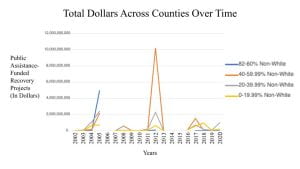
Over seventeen years ago Hurricane Katrina devastated the City of New Orleans causing 186.3 billion dollars in damage and taking 1,833 lives (U.S. Billion-Dollar Weather & Climate Disasters 1980-2022, 2022). This tragedy instigated public discontent with the way the government handled environmental disasters in areas that are primarily populated by minorities. Many people believe that the multitude of government failures that led up to Katrina and after it made landfall would not have happened in a city populated with white residents. Environmental justice and activism groups have fought over the years to combat racial disparities in disaster recovery.
After looking into the mountain of news articles, first hand accounts, and prior academic research to suggest that Federal Emergency Management Agency provides favorable funding to communities with a lower percentage of non-white residents, I presumed this to be true. I hypothesized that as the percentage of non-white residents within a county increases Federal Emergency Management Agency aid for hurricane recovery will decrease.
Using Federal Emergency Management Agency aid allocations solely from public assistance-funded recovery projects I looked at distribution at the county and state level as well as over time. The funding in this data set went to public lands and facilities damaged in a hurricane. This led me to two key findings.

First, Federal Emergency Management Agency aid is generally distributed based on damage incurred. At the state level there are no patterns of disproportionate funding based on the racial composition of a state. The most interesting thing at the state level of analysis is that Louisiana and Mississippi are major outliers, receiving over twice as much funding at the third highest per capita funding in a state. These two states are unsurprising as they have borne the impact of many high intensity hurricanes from 2000-2020. It is also important to note that both states have a non-white percentage higher than the national average. In addition, over time hurricane funding spikes in years that correlate to some of the costliest hurricane events in the United States; Hurricane Katrina and Hurricane Sandy. To break down the funding by year I grouped counties by 0-19.99%, 20-39.99%, 40-59.99%, and 60-82% non-white residents. In these two years where there was increased funding, all demographic groups have increased aid allocated to them but not all at the same rate. The amount of funding given to a grouping was in large part determined by the racial composition of the counties that experienced the greatest hurricane damage. In summation, although certain areas receive significantly greater funding than others at the state level and over time, it appears to be driven by counties that received the greatest damage.

Secondly, when looking at the Federal Emergency Management Agency public recovery projects at the county level there may be some bias at certain levels of funding. Similar to the other findings, counties that receive the highest amount of aid represent counties with the greatest amount of damage, such as Orleans Parish, Louisiana where the City of New Orleans is located. However, when looking at counties with mid-range funding (between $50 and $200 per capita) there does appear to be less funding awarded to counties with a higher percentage of non-white residents. Looking further at counties below $50 in per capita aid this pattern no longer exists. This finding suggests that at certain ranges of funding the Federal Emergency Management Agency could demonstrate biases.
Although this may seem promising for equality in hurricane disaster aid, this is just one small piece of the puzzle that creates the bigger picture of what goes into recovery aid. Public recovery projects are just one type of ex-post facto mitigation provided by the Federal Emergency Management Agency. There are also proactive mitigation grants that can be applied for before a disaster event occurs that help to curb future damages. Another limitation of this study was the ability to control for other social factors such as income and education that may have had an affect on the amount of aid received. Lastly, breaking down demographics into more specific racial categories and ethnicities would create a more encompassing study on the relationship between racial demographics and Federal Emergency Management Agency’s aid distribution.
Kendyl Smith is a Senior at Indiana University studying Public Affairs at the O’Neill School of Public and Environmental Affairs. Kendyl is majoring in environmental management with minors in political science and nonprofit management. Next year, she hopes to gain experience at an environmental nonprofit before continuing her education to obtain her law degree with a focus on environmental law
Leave a Reply